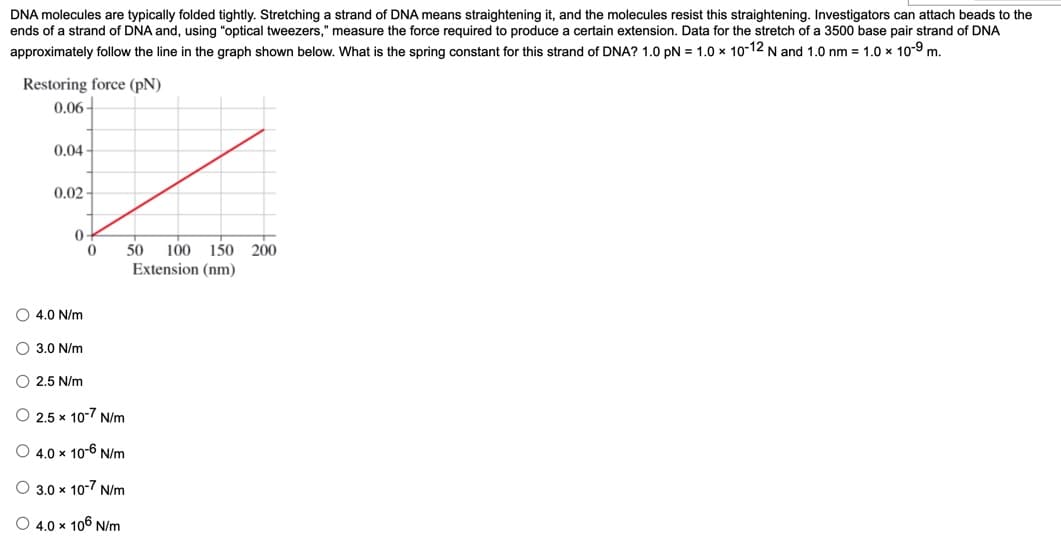DNA molecules are typically folded tightly. Stretching a strand of DNA means straightening it, and the molecules resist this straightening. Investigators can attach beads to the ends of a strand of DNA and, using "optical tweezers," measure the force required to produce a certain extension. Data for the stretch of a 3500 base pair strand of DNA approximately follow the line in the graph shown below. What is the spring constant for this strand of DNA? 1.0 pN=1.0 x 10-12 N and 1.0 nm = 1.0 x 10-9 m. Restoring force (pN) 0.06- 0.04- 0.02- 0 4.0 N/m 3.0 N/m 0 O 2.5 N/m O 2.5 x 10-7 N/m 50 100 150 200 Extension (nm)
DNA molecules are typically folded tightly. Stretching a strand of DNA means straightening it, and the molecules resist this straightening. Investigators can attach beads to the ends of a strand of DNA and, using "optical tweezers," measure the force required to produce a certain extension. Data for the stretch of a 3500 base pair strand of DNA approximately follow the line in the graph shown below. What is the spring constant for this strand of DNA? 1.0 pN=1.0 x 10-12 N and 1.0 nm = 1.0 x 10-9 m. Restoring force (pN) 0.06- 0.04- 0.02- 0 4.0 N/m 3.0 N/m 0 O 2.5 N/m O 2.5 x 10-7 N/m 50 100 150 200 Extension (nm)
University Physics Volume 1
18th Edition
ISBN:9781938168277
Author:William Moebs, Samuel J. Ling, Jeff Sanny
Publisher:William Moebs, Samuel J. Ling, Jeff Sanny
Chapter7: Work And Kinetic Energy
Section: Chapter Questions
Problem 39P: A bungee cord is essentially a very long rubber band that can stretch up to four times its...
Related questions
Question

Transcribed Image Text:DNA molecules are typically folded tightly. Stretching a strand of DNA means straightening it, and the molecules resist this straightening. Investigators can attach beads to the
ends of a strand of DNA and, using "optical tweezers," measure the force required to produce a certain extension. Data for the stretch of a 3500 base pair strand of DNA
approximately follow the line in the graph shown below. What is the spring constant for this strand of DNA? 1.0 pN = 1.0 x 10-12 N and 1.0 nm = 1.0 × 10-9 m.
Restoring force (pN)
0.06-
0.04
0.02-
0-
4.0 N/m
O 3.0 N/m
0
O 2.5 N/m
O 2.5 x 10-7 N/m
O 4.0 x 10-6 N/m
O 3.0 x 10-7 N/m
○ 4.0 x 106 N/m
50 100 150 200
Extension (nm)
Expert Solution
This question has been solved!
Explore an expertly crafted, step-by-step solution for a thorough understanding of key concepts.
This is a popular solution!
Trending now
This is a popular solution!
Step by step
Solved in 3 steps with 2 images

Knowledge Booster
Learn more about
Need a deep-dive on the concept behind this application? Look no further. Learn more about this topic, physics and related others by exploring similar questions and additional content below.Recommended textbooks for you

University Physics Volume 1
Physics
ISBN:
9781938168277
Author:
William Moebs, Samuel J. Ling, Jeff Sanny
Publisher:
OpenStax - Rice University

Principles of Physics: A Calculus-Based Text
Physics
ISBN:
9781133104261
Author:
Raymond A. Serway, John W. Jewett
Publisher:
Cengage Learning

College Physics
Physics
ISBN:
9781305952300
Author:
Raymond A. Serway, Chris Vuille
Publisher:
Cengage Learning

University Physics Volume 1
Physics
ISBN:
9781938168277
Author:
William Moebs, Samuel J. Ling, Jeff Sanny
Publisher:
OpenStax - Rice University

Principles of Physics: A Calculus-Based Text
Physics
ISBN:
9781133104261
Author:
Raymond A. Serway, John W. Jewett
Publisher:
Cengage Learning

College Physics
Physics
ISBN:
9781305952300
Author:
Raymond A. Serway, Chris Vuille
Publisher:
Cengage Learning

College Physics
Physics
ISBN:
9781285737027
Author:
Raymond A. Serway, Chris Vuille
Publisher:
Cengage Learning

Physics for Scientists and Engineers: Foundations…
Physics
ISBN:
9781133939146
Author:
Katz, Debora M.
Publisher:
Cengage Learning

College Physics
Physics
ISBN:
9781938168000
Author:
Paul Peter Urone, Roger Hinrichs
Publisher:
OpenStax College